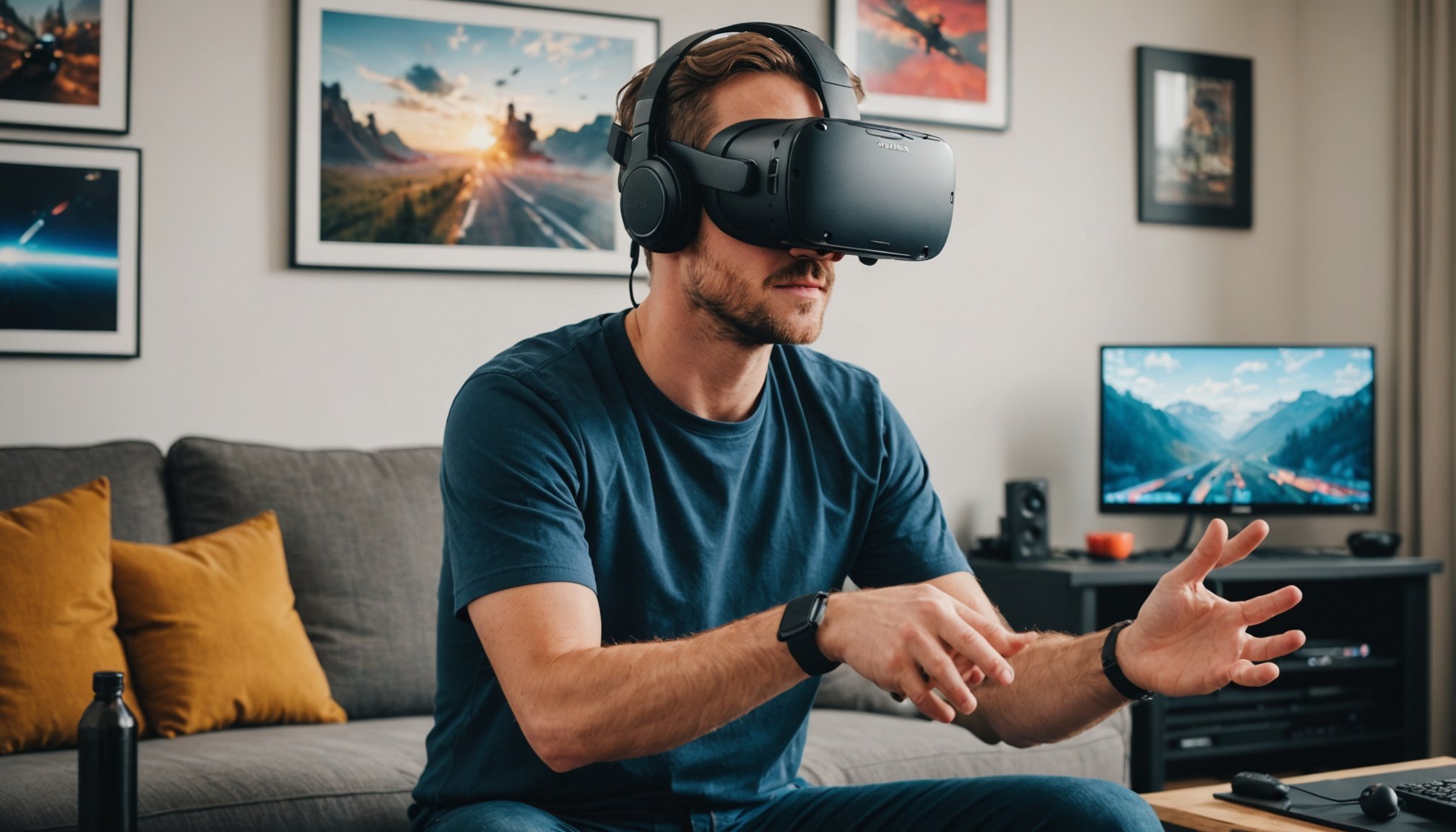Understanding the Basics of VR and Classic Gaming
VR gaming immerses players in a virtual environment using headsets, controllers, and sensors to provide an interactive experience. This technology offers unique features such as real-time interaction and a 360-degree view, creating a sense of presence within the game world. It requires specialized hardware that tracks head movements and translates them into corresponding actions within the game, enhancing the player’s sense of immersion.
In contrast, classic gaming is typically experienced through consoles or PCs with a monitor or TV. Traditional gaming often involves using gamepads or keyboards, delivering a rich experience through detailed graphics and engaging storytelling rather than immersive environments. Popular systems include those from prominent brands like PlayStation, Xbox, and Nintendo.
Also to read : Revolutionizing multiplayer survival games: how ai transforms player engagement and experience
The primary gaming differences are the level of player immersion and physical interaction. While VR gaming allows players to physically move and interact with the game world, classic gaming relies more on hand-eye coordination and strategic gameplay through controllers. Despite these differences, both formats share similarities, such as focusing on creating engaging experiences and fostering competitive or cooperative play among users. Understanding these elements can help gamers choose the most suitable platform for their preferences.
Essential Hardware for Transitioning Between VR and Classic Gaming
Transitioning between virtual reality (VR) and traditional gaming involves careful consideration of gaming hardware to ensure compatibility and enhance the overall experience.
Also to read : Unlocking the future: how blockchain technology revolutionizes secure transactions in gaming
Recommended VR Headsets
When selecting a VR headset, it’s crucial to consider compatibility with various gaming platforms and the quality of immersive experience they provide. Top contenders include:
- Oculus Quest 2: Praised for its standalone capability and ease of use.
- HTC Vive: Known for high-end experiences with precise motion tracking.
- Valve Index: Offers superior visuals and refresh rates for more intense gameplay.
Each has its pros and cons, and selecting the right one depends on balancing these features with your specific gaming needs.
Gaming Consoles and PCs Compatibility
A diverse range of gaming console and PC systems support VR, although the level of compatibility varies. Powerful PCs with robust graphics cards are typically more adaptable for VR integration. Popular consoles like the PlayStation 5 cater to a blend of VR and classic gaming, providing extensive gaming compatibility.
Peripherals to Enhance the Experience
Incorporating compatible gaming peripherals is essential. Key peripherals include:
- Motion controllers: Enhance VR interaction.
- High-fidelity headphones: Provide immersive audio.
- Ergonomic chairs: Offer comfort for extended sessions.
Selecting peripheral devices that seamlessly function in both VR and classic gaming setups can significantly uplift your gaming experience.
Techniques for Seamless Transitions
Switching between VR and traditional gaming can be a breeze with the right transition techniques. A thoughtful step-by-step guide is essential for maintaining immersion and smooth gameplay throughout. Begin by briefly pausing the game to acclimate to the new environment. This pause helps recalibrate your senses, crucial for both VR immersion and traditional gaming.
Strategies for maintaining immersion involve adjusting your gameplay approach based on the medium. In VR, engage fully with spatial movements and interactions. For traditional formats, focus on visual cues and controller feedback to keep the engagement high. Adapting these gameplay strategies ensures that the experience remains captivating.
When adjusting gameplay based on the medium, consider these tips:
- Familiarize yourself with different control schemes.
- Adjust visual settings to match the medium’s strengths.
- Set the gaming environment to minimize distractions.
These tactics help bridge the two gaming styles, fostering a seamless transition. Ensuring your setup accommodates both formats enhances the overall experience, allowing players to enjoy the best of both worlds. Prioritizing these elements can significantly enhance the quality and enjoyment of gaming sessions.
Game Recommendations for Easy Switching
For those venturing into VR games for the first time, selecting the right titles is crucial for a smooth introduction. Here are some recommendations to ease your journey into this virtual world.
Top VR Games for Beginners
Beginner-friendly VR experiences are essential for an enjoyable start. Games like “Beat Saber” and “Job Simulator” offer intuitive controls and simple mechanics, making them perfect for new players. “Beat Saber” engages players with rhythmic swipes, while “Job Simulator” provides humor and straightforward tasks.
Best Classic Games to Explore
Transitioning between formats is seamless when classic games are included. Iconic titles such as “Super Mario Bros.” and “The Legend of Zelda” provide familiarity while offering captivating challenges. These games have historic charm yet remain relevant in today’s gaming world.
Games that Facilitate Smooth Transitions
Transitioning between classic and VR games should be enjoyable. Games like “Minecraft” in both VR and classic formats help bridge the gap. This game offers creativity and exploration, enabling players to adapt flexibly between traditional and virtual realities.
This blend of VR and classic game selection ensures a well-rounded experience, enhancing the enjoyment and ease of switching formats.
Personal Experiences and Anecdotes
The transition from traditional gaming to virtual reality (VR) can be an exhilarating journey filled with unique challenges and rewarding experiences. Many gamers recount initial awkwardness when adopting VR, likening it to learning a new language of movement and interaction. One gamer shared that experiencing vertigo was initially discouraging, but through perseverance, they discovered useful VR tips to overcome it, such as adjusting the interpupillary distance settings.
Anecdotes abound of players inadvertently bumping into furniture or walls while fully immersed in VR worlds, teaching valuable spatial awareness lessons that extend into physical space adjustments. One key lesson learned from these gaming anecdotes is the importance of securing a clear play area to avoid mishaps, enhancing both safety and enjoyment.
Insights into enhancing gaming joy during these transitions often revolve around patience and exploration. Experimenting with different VR setups and controls can significantly improve user experience and provide a more intuitive and comfortable playstyle. Embracing these gamer experiences not only refines technical skills but also fosters a deeper connection to the immersive storytelling that VR uniquely offers.
Visual Aids and Resources for Better Understanding
Visual aids and resources can significantly enhance a gamer’s experience, providing a better grasp of both VR guides and traditional systems.
Charts for Hardware Compatibility
Gaming visuals often include charts to explain hardware compatibility between VR guides and standard gaming setups. These charts help gamers identify which components work seamlessly with VR systems, allowing for informed purchasing decisions. Understanding these compatibilities ensures gamers enjoy a smooth transition into virtual reality without encountering technical hiccups.
Infographics on Transition Techniques
Transitioning from traditional gaming to VR can be complex. Infographics offer an engaging method to present VR guides and transition techniques. They highlight essential tips, such as steps to correctly set up a VR space, system requirements, and user safety precautions. These infographics simplify information, making it accessible and easy to follow even for newcomers.
Video Tutorials for Practical Tips
Video tutorials serve as an excellent resource for practical tips on integrating VR into a gaming routine. Such instructional videos demonstrate VR guides, showcasing how to optimise gameplay and adapt to VR environments. By visually displaying techniques, these videos provide a more comprehensive understanding, aiding in a smoother transition for both novice and experienced gamers.











